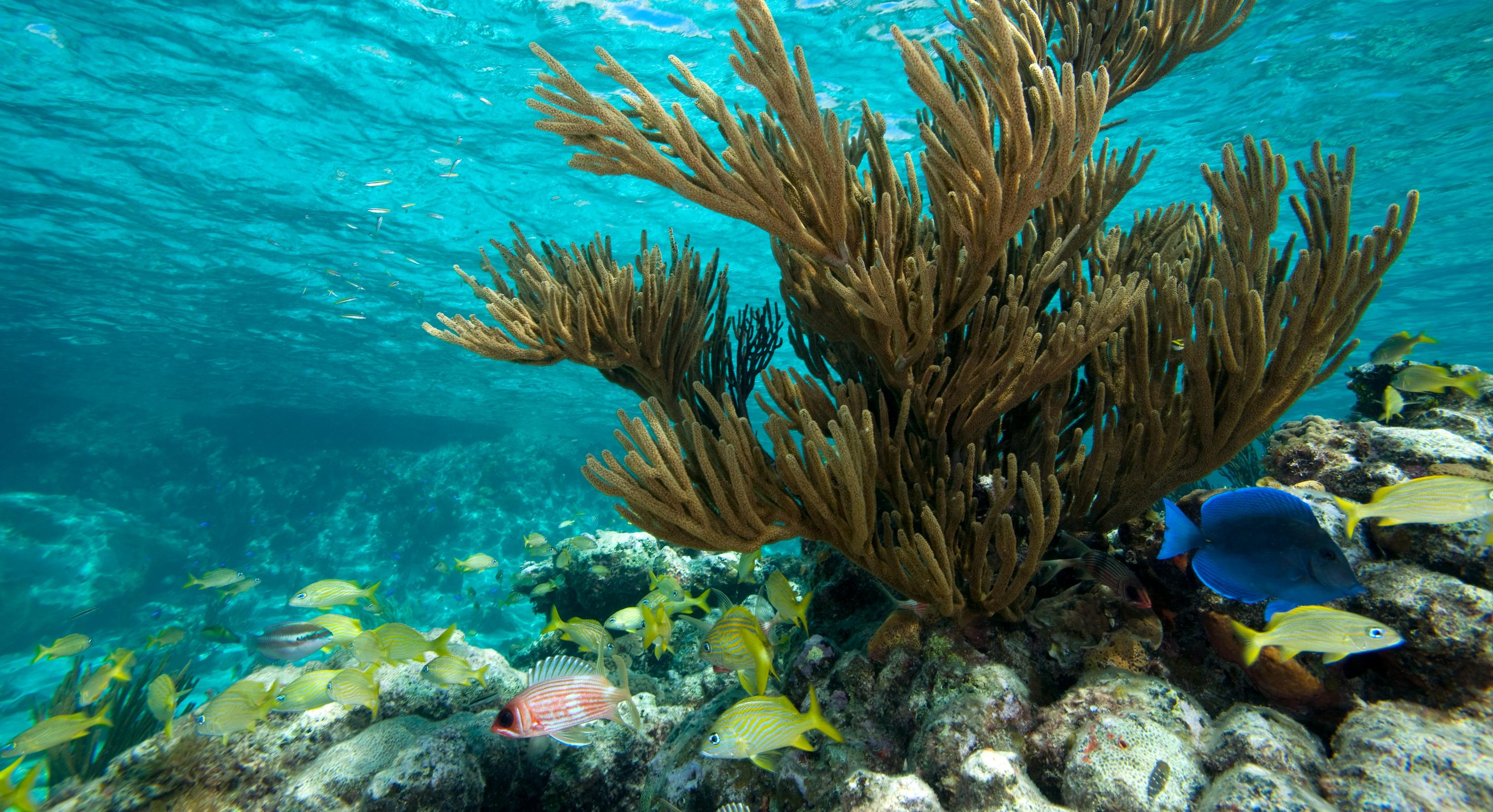Protecting nature starts with science. Here’s a roundup of recent scientific research published by Conservation International experts.
1. In the face of climate change, Caribbean corals are crumbling
Adapted to stressful environmental conditions, some coral species in the Caribbean such as Agaricia, Porites and Orbicella have persisted in the face of numerous threats — from pollution to overfishing to climate change.
But even these corals — some of the hardiest in the world — are now dying out, a recent study found.
By combining fossil data, historical records and underwater surveys, a group of scientists — led by Conservation International’s Katie Cramer — recently tracked changes in the composition of coral species across the Caribbean over the past 130,000 years, before humans settled in this region. They found that in the 1960s fishing and pollution decimated the tall, branching Acropora corals that once dominated the Caribbean. This led to an increase in more stress-tolerant coral species throughout the 1980s and 1990s.
But their rise was short-lived, explained Cramer.
“The combined effects of local stressors and climate change are making many Caribbean reef environments inhospitable to even the most durable corals,” she said. “They’ve hit their breaking point.”
The worst part, Cramer added, is that these corals are “reef-building” species, which accumulate massive layers of calcium carbonate and combine with other organisms to form fully functioning reef ecosystems. Their loss could jeopardize the future of entire reefs — and the numerous species they support.
“Just like trees create habitats for birds and insects, reef-building coral species create habitats for a variety of fish and other marine life,” Cramer said. “To help them withstand the looming impacts of climate change, we have to give them some relief in the near term by improving water quality and promoting sustainable fisheries management techniques.
2. Indigenous peoples are critical to conserving Earth’s biodiversity
Though they account for only 5 percent of the world’s population, Indigenous peoples own or govern nearly a third of Earth’s land area, a recent report found.
Co-authored by 30 Indigenous communities, human rights experts and environmental organizations — including Conservation International — the report showed that the majority of these lands are in good condition, with thriving populations of wildlife and a wealth of plant species.
“Indigenous peoples bring essential knowledge, experience and guidance to conservation efforts,” said Conservation International’s Minnie Degawan, a member of the Kankanaey-Igorot Indigenous group in the Philippines. “Our ideas and expertise are rooted in our long-standing relationship with nature and this study illustrates the importance of collaboration.”
Globally, Indigenous lands are facing increased pressure from development, mining and farming. According to the report’s authors, officially recognizing Indigenous territories by establishing formal, legally binding land rights and ensuring access to resources such as funding and technical support for Indigenous communities is crucial to maintaining these lands — and meeting global goals to conserve the planet’s biodiversity.
For example, the formal recognition of and support for Indigenous lands in the Philippines could almost double the area of conserved land from 16 percent to 27 percent. Overall, Indigenous-managed lands show less species decline and pollution, and more well-managed natural resources.
“We must be present and our voices must be valued as part of the global conversation,” added Degawan, who leads the Indigenous and Traditional People Program at Conservation International. “There is great opportunity for governments, non-governmental organizations and others to work in partnership with Indigenous peoples and local communities toward the collective goal of protecting and conserving Earth’s biodiversity.”
3. A high-resolution map of South Africa’s soil carbon reserves
Using spatial data and machine learning, a team of scientists recently created the most detailed map to date of the carbon stored in South Africa’s soil and tracked how it has changed over time.
Compiling more than 11,000 soil samples and satellite imagery, they found that the total carbon stored in South Africa’s soils has increased by 0.3 percent over the past 30 years.
However, according to the authors, that is not necessarily a good sign.
“As humanity releases more carbon dioxide into the air and climate change accelerates, some areas of South Africa are becoming warmer and wetter, spurring the growth of trees including invasive species,” said Heidi-Jayne Hawkins, one of the study’s co-authors and a scientist at Conservation South Africa — the local affiliate of Conservation International.
“Given the focus on tree planting for climate mitigation, more trees may always seem like a positive change, but too much woodiness in grasslands and savannas removes food for wild and domestic grazers, as well as habitat for birds and other wildlife.”
The study found that other ecosystems throughout South Africa, such as the arid shrublands of the Karoo region, saw a small loss of soil carbon over the past three decades. This was likely driven by climate change and overgrazing, the study’s authors concluded.
Fortunately, the high resolution of this new map allows governments, businesses and individuals to pinpoint the areas are that are most crucial to protect in order to prevent the release of soil carbon. Additionally, data from the map could help communities develop and monitor carbon credit projects that could help financially support the protection of these ecosystems, while stimulating local economies, Hawkins explained.
“An unsung climate hero, soil holds three times more carbon globally than the atmosphere,” she said. “We must protect the limited reserves of carbon in South Africa’s soil — particularly across the country’s rangelands — to slow climate breakdown.”
Kiley Price is the staff writer and news editor at Conservation International. Want to read more stories like this? Sign up for email updates. Donate to Conservation International.
Cover image: A school of tuna in the Maldives (© Sebastian Pena Lambarri/Unsplash)
Further reading:
